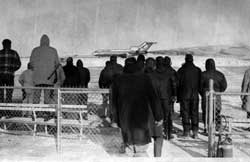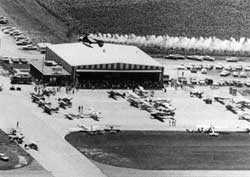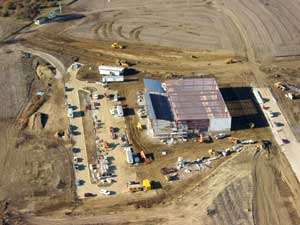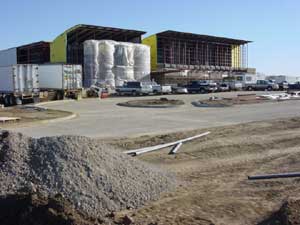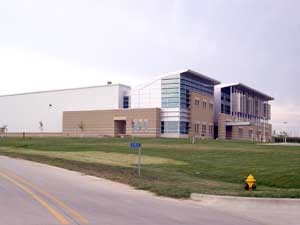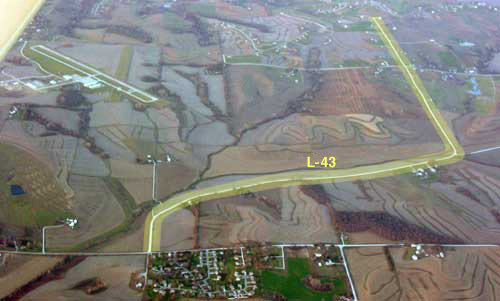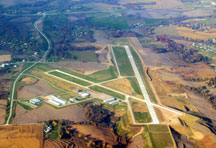Perhaps the most productive period in the history of the Council Bluffs, Airport was during the 1960’s. A new airport emerged, a modern facility, meeting the aviation needs of the entire metropolitan area and southwest Iowa.
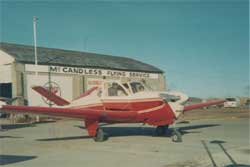
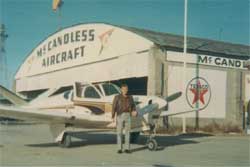
On May 29, 1960, the Nonpareil reported that the Council Bluffs Airport was a pacesetter among Iowa airports. Statistics from the Iowa Department of Aeronautics provided a comparison of the Council Bluffs Airport and those of other Iowa communities. In two years, Iowa had a 38% increase in the number of registered planes. Council Bluffs experienced a 40% increase. Seventy planes were listed as based at the airport. The facility had a two-year perfect safety record – no fatalities. Iowa’s 78 municipally owned airports housed an estimated 707 planes used for business. Council Bluffs claimed 5% of the total. Based on population, the local airport had one plane for every 787 persons in town. Increases in planes were attributed to increased business flying in Omaha and Council Bluffs. The new nearly completed six-plane hangar was to be occupied entirely by business aircraft. Other anticipated improvements had been postponed until the Commission learned how soon the new Interstate would be constructed.
In December 1952, Howard Shortley reported that the Commission had adopted a “wait and see”: attitude about moving the airport. It would be determined by the Highway Commission, which as a part of its five-year plan, would begin purchase of airport land for the Interstate. The Airport Commission as well as the F.A.A had looked at several new sites.
In January 1963 it was announced that the Iowa Aeronautics Commission had approved the location of the new Council Bluffs Airport about six miles east of the City. Approval of the site by the Commission and the F.A.A., made available federal funds for construction and improvements.
One June 29, 1964, Council Bluffs applied for federal funds through the F.A.A. Federal Aid Airport Program. The total project cost was $832.930. Fifty-eight percent ($483,965) was the local match, and forty-two percent ($348,865) was requested from the F.A.A. $460,000 was to come from the sale of the existing airport to the Iowa Highway Commission.
In December 1964, an informal meeting with the Council and the Airport Commission was held in City Manager Paul Whites’ office. The selected site, east of the City was approved. Negotiations with the Highway Commission and the local airport group for the purchase of right-of-way in the existing facility would proceed the following month. The State had proposed to buy about 63 acres of the 194-acre airport for construction of Interstate Highways 29 and 80. However, it was indicated that the State might bid for the whole tract.

Proposed Airport
On March 30, 1965, The Council tentatively adopted a resolution to enter into contract with the Iowa State Highway Commission for the sale of the Council Bluffs Airport. A public hearing was set for April 19, 1965. Price of the sale was $400,000 with $100,000 being retained by purchased until possession. Council Bluffs was allowed to retain possession and use of the property until needed, but not later than October 1, 1965. Council Buffs however, retained the right to continue the use of the two north / south runways until May 1, 1966. Permission to use hangars for the storage of aircraft was also given. The Highway Commission was to give 30 days notice prior to taking physical possession.
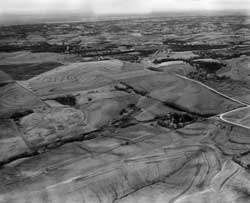
New home for the Council Bluffs Airport
Bluffs ready for giant step into air age; plans an $850,000 facility,” were the Nonpareil bylines of reporter John Albright’s April 25 article on airport plans. The Airport Commission hoped to start negotiations soon on a 330-acre site, 3 _ miles east of Council Bluffs. It was appraising properties near the farmhouses of Al Martin and Marion Shugart on the south side of Highway #6. The largest parcel, 160 acres fronting on Highway #6, belonged to Martin. Shugart owned a 43-acre parcel west of the Martin land and a 100-acre tract on the south side of the proposed site. Three other rural residents owned property at the southeast corner of the site: Felix Barth, 20 acres; Virgil Anderson, 4 acres; and Ed Witthauer, 3 acres. The plan called for phased development in 1965; one runway and a single building for a shop, hangar and office would be constructed. In 1966, taxiways, access roads, utilities and other buildings would be completed. The Iowa Aeronautics Commission was asked to set aside $25,000 from the Air Fuel Tax Fund for use by the local Commission as local match of federal dollars before June 30, 1966.
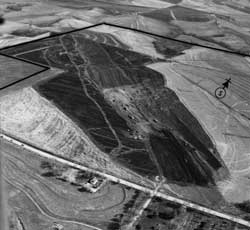
New home for the Council Bluffs Airport
On June 7, 1965, the Council adopted a resolution for the purchase of land from H. Martin, A.F. Martin and Winifred Martin.
The construction of a new airport facility received top priority on the City’s list of projects for 1966. Specifications called for grading and construction of drainage facilities, the paving of a 4,100-foot Northwest/Southeast runway, construction of an access road, taxiway and apron, installation of a 15,450 foot wire mesh fence, and 140 acres of grass seeding.
On March 15, 1966, officials and engineers reduced the length of runway 500 feet, also reducing the cost estimate to $399,000. The runway was consequently shortened from 4,100 to 3,600 feet.

New home for the Council Bluffs Airport
In early May 1966, it was decided that the Airport Commission would become advisory and an airport manager would be hired, perhaps a fixed based operator. The Airport Commission had operated independently since the 1930’s. Harry McCandless, Flight Service Operator, had been lessee and manger of the airport for the prior fifteen years.
It was also decided to have 30 t-hangars, 15 with ports and 15 without. Facilities for ten planes would be built, using the open aeroport design of building. Plans and specifications on construction were to be filed with the City council at the first meeting of January 1967, with a proposed public hearing on February 1, 1967.
It was reported by the Nonpareil on December 3, 1966, that Harry McCandless would resign as operator of the Municipal Airport on December 31. “I’m not too interested in the new one,” he told the Nonpareil. “It’s going to be a pretty big operation and it might be too much for me to handle.” McCandless had started as airport manager in July 1951 succeeding Jim Cook.
The Airport Commission met again on December 30, 1966, presenting McCandless a memorandum commending him for his ten years of service to the Council Bluffs Airport. All the Commission members signed it. Upon seeing the plans for the new facility, Mr. McCandless indicated that he might still be interested in being a fixed base operator for the new airport.
On June 25, William Frueh reported that the new airport had received F.A.A. approval and the old airport would be closed.
The new airport was scheduled to be dedicated on July 4, 1967 at 10:30 am in front of the main hangar.
It was perfect flying weather. More than fifty pilots registered for the breakfast. Two hundred persons opened the festivities.
There were 10,900 people at opening day events. The ribbon was cut by airplane propeller. Inside the plane were Lewis Ross, Jr., Chairman of the Airport Commission, F.B.O. Ray Surges and Mayor pro tem Dr. Walter Hathaway.
The F.A.A. grant allocation of $11,500 for airport runway lighting, was welcome news when received on September 5.
On December 24, 1969, an agreement with F.A.A. for a $50,000 grant was signed, setting in motion the construction of a parallel taxiway to the northwest/southeast runway and connecting taxiway, installation of electric duct work under the taxiway and seeding.
Council Bluffs had a brand new airport facility and its potential was never greater.
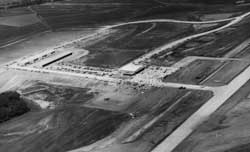
New Airport Facility
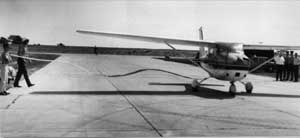
Airplane on New Runway

